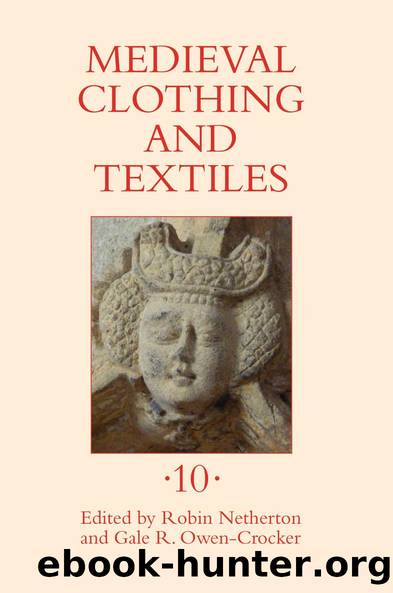Medieval Clothing and Textiles 10 by Robin Netherton Gale R. Owen-Crocker

Author:Robin Netherton, Gale R. Owen-Crocker [Robin Netherton, Gale R. Owen-Crocker]
Language: eng
Format: epub
ISBN: 9781783274741
Barnesnoble:
Publisher: Boydell & Brewer, Limited
Published: 2019-11-29T00:00:00+00:00
CLOTHING DISTRAINED FOR DEBT
Articles of clothing distrained for debts consisted primarily of menâs and womenâs main outer garments: gowns, tunics, doublets, overdresses (guarnacchia), and cloaks.5 No childrenâs clothes are mentioned. It might perhaps be thought that childrenâs clothing had little value and was likely to be sold or passed on when the child had outgrown it, but items of childrenâs clothing do appear in inventories and clearly had some value. It seems likely that at least some of those being distrained for debts would have childrenâs garments that were not immediately needed; nevertheless none appear in these lists. There are also virtually no undergarments. Again underwear might be thought to have little value and in any case played a relatively minor role in medieval dress. The inclusion of a womanâs shirt and a manâs shirt (camicia), both of them new, among the items taken for the £10 picc. owed by Federigo Johannis shows that underwear might be taken, but this remains the only example.6 There are few examples of minor articles of clothing. There are no mentions of separate sleeves, although pairs of sleeves quite frequently occur in contemporary inventories. Married women normally wore veils, coifs, or wimples and girls garlands and other forms of headdress, but none appear in these lists, though minor textile articles such as hand towels are sometimes mentioned. Hoods were worn by both sexes, but were very rarely among the items distrained for debts; a pale blue hood was taken from Francesco Blasi along with a vermilion silk lining for a manâs cloak for a debt of 1 florin in 1370, and three different hoods, two of them menâs and one a womanâs, were taken from the weaver Tuccio Ricci, known as Tristano, for a debt of 1 florin in 1380, along with a womenâs tunic of panno albagio (locally produced woollen cloth) and a leather hat,7 but these remain isolated examples. The only gloves mentioned were in fact a pair of iron gauntlets.8 Hose and footwear are very rarely mentioned, apart from cases where the distraint was against a hosier or a shoemaker. A pair of hose made of white English wool was among the items taken from Zacchino Nelli in June 1380, but he was a tailor and they are likely to have been part of his stock.9 This must also have been the case for Benincasa Pardelli, a shoemaker, who had a long list of items of furniture and bedding and also twenty-two pairs of boots (aluctarum), sixty-two pairs of clogs (soccholis), 176 pairs of forms for boots, two pairs of uppers for shoes (tomariis), and various skins and wood taken on May 29, 1380,10 and Jacobo Nerii, a shoemaker, who had twenty-two pairs of boots for women and children (the only mention of children in these lists) and fifty-seven pairs of forms for boots, large and small, taken on June 18.11 Apart from these, footwear is mentioned only among the articles taken from a Florentine furrier, Johanne Amadoris, but he and
Download
This site does not store any files on its server. We only index and link to content provided by other sites. Please contact the content providers to delete copyright contents if any and email us, we'll remove relevant links or contents immediately.
| Decorative Arts | Design History & Criticism |
| Furniture Design | Industrial & Product Design |
| Interior & Home Design | Jewelry Design |
| Textile & Costume |
POP by Steven Heller(3307)
Japanese Design by Patricia J. Graham(3107)
The Power of Broke by Daymond John(2895)
Architecture 101 by Nicole Bridge(2760)
Indistractable: How to Control Your Attention and Choose Your Life by Nir Eyal(2331)
Fusion 360 for Makers by Lydia Sloan Cline(2308)
Batik by Rudolf Smend(2123)
Actionable Gamification: Beyond Points, Badges, and Leaderboards by Yu-kai Chou(2122)
Origami Art by Michael G. Lafosse & Richard L. Alexander(2062)
Homebody by Joanna Gaines(2029)
Whiskey in a Teacup by Reese Witherspoon(1935)
Worn in New York by Emily Spivack(1926)
Feng Shui by Stephen Skinner(1899)
Austin Kleon by Steal Like an Artist(1883)
Simple Gatherings by Melissa Michaels(1855)
Don't Make Me Think, Revisited: A Common Sense Approach to Web Usability by Steve Krug(1825)
Hygge: The Danish Art of Happiness by Marie Tourell Søderberg(1693)
The Joy of Hygge by Jonny Jackson(1681)
The Laws of Simplicity by John Maeda(1568)
